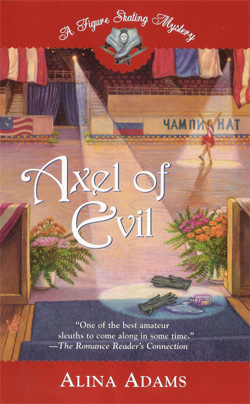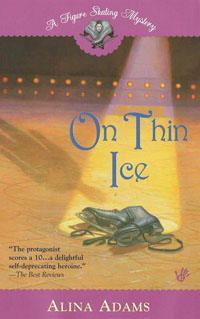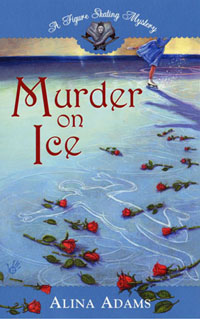SHOW ME THE MONEY!
This weekend's New York Times Magazine presents a multi-page (if you're reading it on-line, a really multi-page) feature, "The Making of an Ice Princess," focusing on Emily Hughes, younger sister of 2002 Olympic Champion Sarah Hughes.
While the piece discusses at length the physical, emotional, sociological and emotional costs of becoming a figure skating champion, it all but waltz-jumps (after a brief, obligatory mention) over the more crass, financial ones.
But, NY Times aside, the fact is, skating takes money.
Lots and lots of money.
Money for skates. A custom-made pair, with specialized free-style, figure or dance blades, can cost close to $1,000.
Money for costumes -- hand-sewn and beaded and embroidered -- another $1,000.
Money for coaches. The more established charge up to one dollar a minute.
Money for private ice, plane tickets to competitions for both skater and coach, hotel charges for skater and coach, off-ice dance lessons, music editing, physical therapy.
A Novice or Junior competitor could easily spend $30,000 a year on skating.
A Senior, International competitor: $100,000.
World Pair Champion Tai Babilonia's father worked two jobs to keep his daughter skating.
Three time U.S. Silver Medalist Lisa-Marie Allen needed her grandparents to help her divorced mother pay the bills.
And World Champion Todd Eldredge got his entire town to join in the effort.
Following his 1985 U.S. Novice title, Todd's parents came to the unhappy realization that they could no longer afford to keep their very talented son skating. That's when the town of Chatham, MA pitched in to help. Neighbors went door to door, and held summer clam bakes to solicit donations. The Chatham Youth Hockey League set up a fund to help with expenses. Laughs Todd, "I'm probably the only figure skater ever supported by a hockey team."
A similar circumstance existed for 1997 Canadian Pair Champions Marie-Claude Savard-Gagnon and Luc Bradet. The two were next-door neighbors living in a small town, Baie-St-Paul in Quebec, and just going to the local ice-rink to hang out, when, at ages twelve and fourteen, a coach spotted them and decided the pair had potential. Neither Marie-Claude nor Luc's family could afford to cover all the costs of a serious skating career, so their community pitched in to help. Every year they competed, the local club presented a skating show, proceeds from which went to support Marie-Claude and Luc.
Those without such an option, however, often needed to resort to even more creative financing techniques. 1992 & 1993 U.S. Pair Champions Calla Urbanski & Rocky Marval earned their nickname "The Waitress and the Truck-Driver," by working at a pair of blue-collar jobs while training for the Olympics.
1994 U.S. Bronze Medalist in Pairs Karen Courtland and former partner David Goodman performed at children's parties as painted clowns, using acrobatic lifts they carried over from skating.
1996 U.S. Men's Champion Rudy Galindo lived in a trailer-park with his mother, pedaled a creaky bike to the rink, and bummed free lessons from his sister, Laura.
Aspiring hopeful Larry Holiday took frugality a step further, and just lived in his car while attempting to qualify for the 1994 Olympics.
He didn't make it.
While the piece discusses at length the physical, emotional, sociological and emotional costs of becoming a figure skating champion, it all but waltz-jumps (after a brief, obligatory mention) over the more crass, financial ones.
But, NY Times aside, the fact is, skating takes money.
Lots and lots of money.
Money for skates. A custom-made pair, with specialized free-style, figure or dance blades, can cost close to $1,000.
Money for costumes -- hand-sewn and beaded and embroidered -- another $1,000.
Money for coaches. The more established charge up to one dollar a minute.
Money for private ice, plane tickets to competitions for both skater and coach, hotel charges for skater and coach, off-ice dance lessons, music editing, physical therapy.
A Novice or Junior competitor could easily spend $30,000 a year on skating.
A Senior, International competitor: $100,000.
World Pair Champion Tai Babilonia's father worked two jobs to keep his daughter skating.
Three time U.S. Silver Medalist Lisa-Marie Allen needed her grandparents to help her divorced mother pay the bills.
And World Champion Todd Eldredge got his entire town to join in the effort.
Following his 1985 U.S. Novice title, Todd's parents came to the unhappy realization that they could no longer afford to keep their very talented son skating. That's when the town of Chatham, MA pitched in to help. Neighbors went door to door, and held summer clam bakes to solicit donations. The Chatham Youth Hockey League set up a fund to help with expenses. Laughs Todd, "I'm probably the only figure skater ever supported by a hockey team."
A similar circumstance existed for 1997 Canadian Pair Champions Marie-Claude Savard-Gagnon and Luc Bradet. The two were next-door neighbors living in a small town, Baie-St-Paul in Quebec, and just going to the local ice-rink to hang out, when, at ages twelve and fourteen, a coach spotted them and decided the pair had potential. Neither Marie-Claude nor Luc's family could afford to cover all the costs of a serious skating career, so their community pitched in to help. Every year they competed, the local club presented a skating show, proceeds from which went to support Marie-Claude and Luc.
Those without such an option, however, often needed to resort to even more creative financing techniques. 1992 & 1993 U.S. Pair Champions Calla Urbanski & Rocky Marval earned their nickname "The Waitress and the Truck-Driver," by working at a pair of blue-collar jobs while training for the Olympics.
1994 U.S. Bronze Medalist in Pairs Karen Courtland and former partner David Goodman performed at children's parties as painted clowns, using acrobatic lifts they carried over from skating.
1996 U.S. Men's Champion Rudy Galindo lived in a trailer-park with his mother, pedaled a creaky bike to the rink, and bummed free lessons from his sister, Laura.
Aspiring hopeful Larry Holiday took frugality a step further, and just lived in his car while attempting to qualify for the 1994 Olympics.
He didn't make it.






0 Comments:
Post a Comment
Links to this post:
Create a Link
<< Home